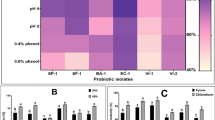Abstract
The aim of this study was to evaluate the probiotic properties of Lactobacillus plantarum Ln1 isolated from kimchi and the antioxidant activities of live and heat-killed cells. L. plantarum KCTC 3108, which has been used as a commercial probiotic strain, was used as a control. L. plantarum strains (Ln1 and KCTC 3108) can survive under artificial gastric conditions (pH 2.5 in 0.3% pepsin for 3 h and 0.3% oxgall for 24 h), and adhere strongly to HT-29 cells. In addition, L. plantarum Ln1 did not produce carcinogenic β-glucuronidase, whereas it showed a higher β-galactosidase production of 3067.42 mU/mL. The antioxidant activity of L. plantarum Ln1 was assessed using the 2,2-diphenyl-1-picryl-hydrazyl (DPPH) and 2,2′-azino-bis-(3-ethylbenzthiazoline-6-sulfonic acid) (ABTS) radical scavenging, β-carotene and linoleic acid inhibition, and reducing power assays. In all these methods, live L. plantarum Ln1 showed a higher antioxidant activity than the control strain. In heat-killed cells of L. plantarum Ln1, β-carotene bleaching inhibitory activity and reducing power was higher than DPPH and ABTS radical scavenging activity. These results suggested that live or heat-killed L. plantarum Ln1 isolated from kimchi might be useful as an antioxidant probiotic.




Similar content being viewed by others
References
Adams CA (2010) The probiotic paradox: live and dead cells are biological response modifiers. Nutr Res Rev 23:37–46
Amaretti A, di Nunzio M, Pompei A, Raimondi S, Rossi M, Bordoni A (2013) Antioxidant properties of potentially probiotic bacteria: in vitro and in vivo activities. Appl Microbiol Biotechnol 97:809–817
Basholli-Salihu M, Mueller M, Salar-Behzadi S, Unger FM, Viernstein H (2014) Effects of lyoprotectants on β-glucosidase activity and viability of Bifidobacterium infantis after freeze-drying and storage in milk and low pH juices. LWT-Food Sci Technol 57:276–282
Choi HJ, Cheigh CI, Kim SB, Lee JC, Lee DW, Choi SW, Park JM, Pyun YR (2002) Weissella kimchii sp. nov., a novel lactic acid bacterium from kimchi. Int J Syst Evol Microbiol 52:507–511
Cuello-Garcia CA, Brozek JL, Fiocchi A, Pawankar R, Yepes-Nunez JJ, Terracciano L, Gandhi S, Agarwal A, Zhang Y, Schunemann HJ (2015) Probiotics for the prevention of allergy: a systematic review and meta-analysis of randomized controlled trials. J Allergy Clin Immunol 136:952–996
Das D, Goyal A (2015) Antioxidant activity and γ-aminobutyl acid (GABA) producing ability of probiotic Lactobacillus plantarum DM5 isolated from Marcha of Sikkim. LWT-Food Sci Technol 61:263–268
Firuzi O, Miri R, Tavakkoli M, Saso L (2011) Antioxidant therapy: current status and future prospects. Curr Med Chem 18:3871–3888
Gobinath D, Prapulla SG (2015) Transgalactosylating β-galactosidase from probiotic Lactobacillus plantarum MCC2156: production and permeabilization for use as whole cell biocatalyst. J Food Sci Technol 52:6003–6009
Gouripur G, Kaliwal B (2017) Screening and optimization of β-glucosidase producing newly isolated Lactobacillus plantarum strain LSP-24 from colostrum milk. Biocatal Agric Biotechnol 11:89–96
Halliwell B, Gutteridge JMC (1989) Free radicals in biology and medicine. Clarendon Press, Oxford, pp 23–30
Jang DJ, Chung KR, Yang HJ, Kim KS, Kwon DY (2015) Discussion on the origin of kimchi, representative of Korean unique fermented vegetables. J Ethn Foods 2:126–136
Jeon EB, Son SH, Jeewanthi RKC, Lee NK, Paik HD (2016) Characterization of Lactobacillus plantarum Lb41, an isolate from kimchi and its application as a probiotic in cottage cheese. Food Sci Biotechnol 25:1129–1133
Ji K, Jang NY, Kim YT (2015) Isolation of lactic acid bacteria showing antioxidative and probiotic activities from kimchi and infant feces. J Microbiol Biotechnol 25:1568–1577
Lee NK, Kim SY, Han KJ, Eom SJ, Paik HD (2014) Probiotic potential of Lactobacillus strains with anti-allergic effects from kimchi for yogurt starters. LWT-Food Sci Technol 58:130–134
Lee NK, Han KJ, Son SH, Eom SJ, Lee SK, Paik HD (2015) Multifunctional effect of probiotic Lactococcus lactis KC24 isolated from kimchi. LWT-Food Sci Technol 64:1036–1041
Li S, Zhao Y, Zhang L, Zhang X, Huang L, Li D, Niu C, Yang Z, Wang Q (2012) Antioxidant activity of Lactobacillus plantarum strains isolated from traditional Chinese fermented foods. Food Chem 135:1914–1919
Park S, Bae JH (2015) Probiotics for weight loss: a systematic review and meta-analysis. Nutr Res 35:566–575
Pennacchia C, Vaughan EE, Villani F (2006) Potential probiotic Lactobacillus strains from fermented sausages: further investigations on their probiotic properties. Meat Sci 73:90–101
Rajoka MSR, Mehwish HM, Siddiq M, Haoin Z, Zhu J, Yan L, Shao D, Xu X, Shi J (2017) Identification, characterization and probiotic potential of Lactobacillus rhamnosus isolated from human milk. LWT-Food Sci Technol 84:271–280
Rekha CR, Vijayalakshmi G (2010) Bioconversion of isoflavone glycosides to aglycones, mineral bioavailability and vitamin B complex in fermented soymilk by probiotic bacteria and yeast. J Appl Microbiol 109:1198–1208
Ren D, Li C, Qin Y, Yin R, Du S, Ye F, Liu C, Liu H, Wang M, Li Y, Sun Y, Li X, Tian M, ** N (2014) In vitro evaluation of the probiotic and functional potential of Lactobacillus strains isolated from fermented food and human intestine. Anaerobe 30:1–10
Son SH, Jeon HL, Jeon EB, Lee N, Park YS, Kang DK, Paik HD (2017) Potential probiotic Lactobacillus plantarum Ln4 from kimchi: evaluation of β-galactosidase and antioxidant activities. LWT-Food Sci Technol 85:181–186
Vidhyasagar V, Jeevaratnam K (2013) Evaluation of Pediococcus pentosaceus strains isolated from Idly batter for probiotic properties in vitro. J Funct Foods 5:235–243
Wang Y, Wu Y, Wang Y, Xu H, Mei X, Yu D, Wang Y, Li W (2017) Antioxidant properties of probiotic bacteria. Nutrients 9:521
Acknowledgements
This research was supported by the Export Promotion Technology Development Program (#116119-03) and Agri-Bio Industry Technology Development Program (#117001-02) of the Korean Ministry of Agriculture, Food and Rural Affairs.
Author information
Authors and Affiliations
Corresponding author
Rights and permissions
About this article
Cite this article
Jang, H.J., Song, M.W., Lee, NK. et al. Antioxidant effects of live and heat-killed probiotic Lactobacillus plantarum Ln1 isolated from kimchi. J Food Sci Technol 55, 3174–3180 (2018). https://doi.org/10.1007/s13197-018-3245-4
Revised:
Accepted:
Published:
Issue Date:
DOI: https://doi.org/10.1007/s13197-018-3245-4




